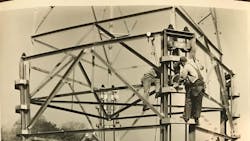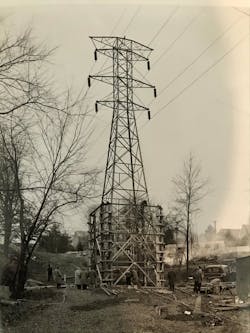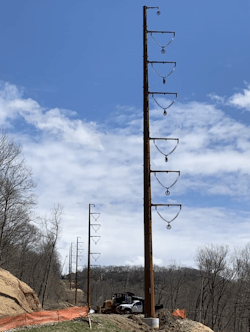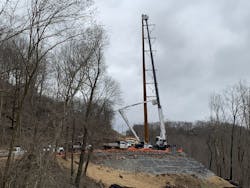Lineworkers Rebuild Century-Old Infrastructure
With the circuits and infrastructure supported by equipment that’s more than a century old, the current towers are nearing their end of life. To ensure continued reliability and resiliency, lineworkers are replacing 99 transmission towers with weathered steel monopoles over a 14.5-mile stretch between the Brunot Island and Crescent Township substations in DLC’s territory.
Modernizing the Line
After securing approval from the appropriate regulatory agencies, DLC and its construction contractor kicked off the five-phase BI-Crescent Transmission Project on Dec. 13, 2021. As of June 2022, the first phase of the project was complete, and the crews were moving into the next four phases of construction. Because the line crosses through congested urban areas, the line crews are working during off-peak load sections of the year like the fall and winter months.
With the line scheduled to be energized in 2027, work is now underway to replace the towers. A significant portion of the early phase of the project was to create and build access roads and work pads to the site. To make the construction site safer and work methods more efficient, the engineering team designed and planned access roads so that large equipment, trucks and materials could be transported and unloaded.
Lineworkers are replacing the galvanized lattice steel structures with weathered steel monopoles from Meyer Utility Structures on double 138-kV vertically stacked circuits. The average height of the current towers is 93 ft, but the new monopoles average about 155 ft high. When increasing the height of the structures, DLC’s engineers consulted the National Electric Safety Code to ensure the monopoles met or exceeded all of the minimum clearance requirements. In addition, they reviewed severe weather cases to ensure the structures would be resilient and reliable, even in heavy snow or high winds.
In addition, transitioning from the towers to the new structures minimizes the footprint of the foundations and reduces inspection and maintenance costs due to fewer bolted connections and steel parts. The towers are wider and have four foundations each, but the new monopoles only have one foundation and a much smaller footprint. The overall inspection and maintenance needs over the new infrastructure’s lifetime is significantly reduced.
Another significant benefit of the weathering steel monopoles is that they do not need to be painted, unlike the lattice steel towers, which must be constantly painted to prevent corrosion. DLC has been replacing the towers with monopoles, not only on the BI-Crescent line, but also in other parts of its service territory. For example, in areas with hills, valleys and narrow spaces, the monopoles are the right solution for that kind of location and terrain.
The stacked circuits are also farther away from trees and other potentially harmful vegetation. The existing circuit has a side-by-side design, but with the monopoles, the circuits are stacked on top. Because all six wires and the shield wire are in a column, the wires are mostly above the treeline. That way, if a tree does fall near the structure, it will most likely miss the wires.
Project in Progress
To modernize the line, the crews first had to build temporary roads into the old towers and then demolish the lattice towers and foundations. Below ground, the foundations are covered up or fully removed. Next, a drill rig drills a large hole to install a concrete caisson foundation with anchor bolts. After pouring the new foundation, the lineworkers set the new monopoles.
As the project progresses, the crew and resource sizes fluctuate. On average, however, 20 contract personnel and three supervisors are on site during the project. When the project hits a milestone and moves into larger phases of construction, DLC may increase the field workforce. Currently, DLC is working with J.W. Didado Electric and may pull in other support contractors in the near future.
To make sure the job is staying on schedule and within budget, the project management team is using best practices such as cost-loaded schedules. Through upfront planning, DLC can involve all of the necessary stakeholders to ensure it has a sound approach to the project.
Due to the complexity of the project, DLC is carefully planning every section of work in detail, and as each part is laid down in the schedule, the team makes sure it can do it safely. As the field workforce encounters any challenges, the team identifies and mitigates these risks. For example, during phase one of the project, DLC’s work crews encountered poor soil conditions, which slowed down construction. Moving forward, the company plans to mitigate this problem and adequately plan for working through the winter months further out in the project.
Because the project is challenging and complex, DLC worked closely with various internal and external stakeholders, including real estate and right-of-way groups, to ensure the project’s success. For example, in environmentally sensitive areas of the project, DLC worked with consultants to map out the wetland and natural resources in the project area and worked very closely with several agencies, including the Department of Environmental Protection. DLC also worked directly with landowners on right-of-way issues before construction started.
Beyond monitoring and tracking the progress on the project, DLC is also making sure it is in alignment with its budget. The company and its engineering contractor performed testing and site preparation to ensure it understands the existing site conditions. That way, engineers can identify any risks before they pose challenges on the project. To keep the job on track, DLC has many team meetings and convenes frequently virtually or in-person.Focus on Safety and Efficiency
To increase productivity on the project, DLC is also using special tools and equipment. In addition to cranes and lifts, the lineworkers are using larger drill rigs and helicopters. DLC is also using drones to record video for inspections during the project. The utility is using light helicopters to pull in lines, and in the future, the utility may consider using a heavy-lift helicopter to fly pole sections into hard-to-reach areas.
Unlike the lineworkers from yesteryear who originally built the lines, today’s construction team has access to heavy tools and equipment, which can improve safety. For example, some of the equipment has remote operations, which makes the work safer for lineworkers, and other equipment helps them do the job more efficiently and quickly.
To further improve the safety of its field workforce, DLC’s safety team establishes expectations for its contractors. Every day, they are required to have pre-job briefs so they can identify all the hazards in the field. As a result, on the large transmission projects, the contractors have performed well and been able to get the first phase of the job done safely.
The monopoles are constructed across a long linear distance, and many of them are in difficult-to-access areas, compounding the challenges on the project. Even so, safety is a key priority on the job. A project of this size and scope has a lot of moving parts, but in the end, it is a long-term and critical infrastructure investment. When DLC completes the project and energizes the line, it is ensuring that it can continue to deliver safe and reliable power for another 100 years.
Editor’s Note: To learn more about the BI-Crescent project, visit DuquesneLight.com/BI-Crescent or email [email protected]. You can also listen to an upcoming Line Life podcast episode about the project by visiting www.tdworld.com/podcasts.
Jason Hartle is a senior project manager for DLC. He has five years of experience in the defense industry and more than 17 years in the electric utility industry. He is currently overseeing DLC’s BI-Crescent project as well as other large transmission and distribution construction endeavors for the company. He graduated from the University of Pittsburgh at Johnstown with a bachelor’s degree in mechanical engineering and is a certified professional project manager.
Meenah Shyu is a general manager of engineering at DLC and has more than 13 years of experience in the electric utility industry. She currently
leads DLC’s Substation, Civil and Transmission Line engineering teams. She graduated from Carnegie Mellon University with bachelor’s and master’s degrees in civil engineering. She is a licensed professional engineer in the state of Pennsylvania.
About the Author
Jason Hartle
Jason Hartle is a senior project manager for DLC. He has five years of experience in the defense industry and more than 17 years in the electric utility industry. He is currently overseeing DLC’s BI-Crescent project as well as other large transmission and distribution construction endeavors for the company. He graduated from the University of Pittsburgh at Johnstown with a bachelor’s degree in mechanical engineering and is a certified professional project manager.
Meenah Shyu
Meenah Shyu is a general manager of engineering at DLC and has more than 13 years of experience in the electric utility industry. She currentlyleads DLC’s Substation, Civil and Transmission Line engineering teams. She graduated from Carnegie Mellon University with bachelor’s and master’s degrees in civil engineering. She is a licensed professional engineer in the state of Pennsylvania.




